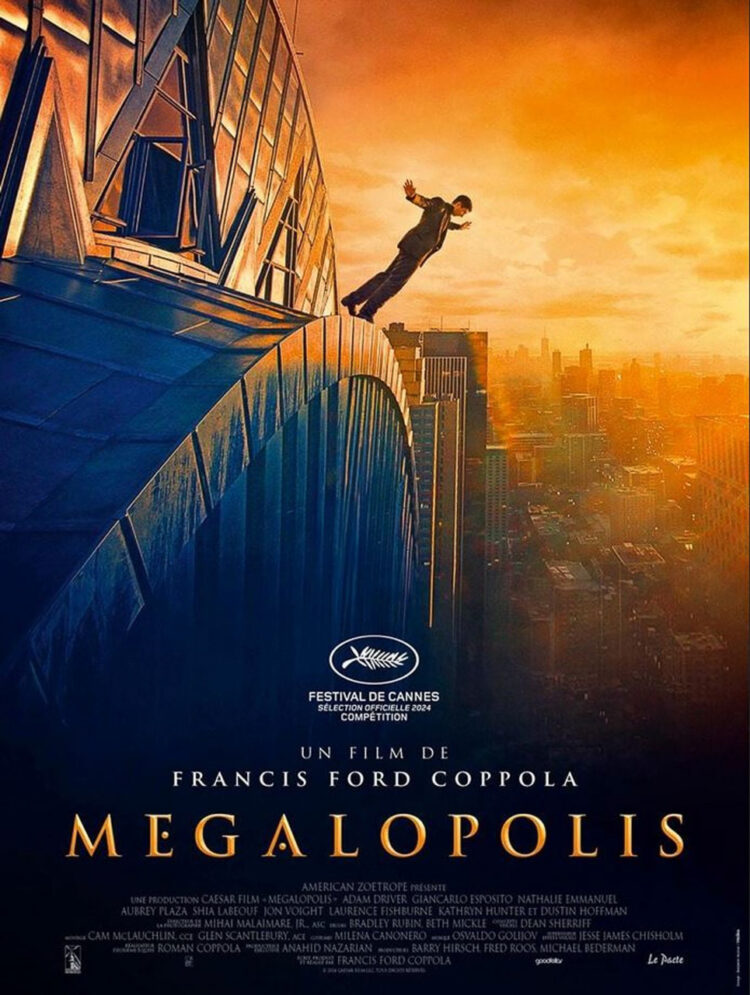From the November 2024 Sight and Sound:

The best and worst to be said about Francis Ford Coppola is that he’s a compulsive reviser of his own self-portraits — not only when it comes to rereleasing new versions of his Godfather films, Apocalypse Now, and The Cotton Club, but even when it comes to his dropping and then reintroducing the ‘Ford’ in Francis Ford Coppola.
Part of what’s both fascinating and frustrating about his most ambitious and audacious film, developed over more than four decades, is the degree to which it revels in its own revisions — provocatively superimposing what looks like later drafts over earlier ones rather than using them as replacements. Far from emerging sadder but wiser, Megalopolis lands in our laps both happier and dumber for its lack of inhibitions. It becomes conventionally digestible only when it occasionally turns into an old-fashioned love story.
The conceit of imagining New York in terms of the Catilinarian conspiracy of 63 BC (an attempted coup d’état to overthrow the Roman consuls with a populist revolt) entails not only a collapse of today, tomorrow, and yesterday, but alternate versions of all three, ergo a city reinvented whenever there’s a new scene to unravel. Sometimes New York is seen as simply Roman, complete with togas; sometimes it’s only vaguely Romanesque – with all its separate settings and conceits threatening to convert a polemical plot into an illustrated lecture presented in a variorum edition. As Tom Charity recently noted in these pages, the “imagery…will not necessarily be tied to literal meaning or the explication of narrative”.
Arguably, this doesn’t do its actors or its audience any favours. Adam Driver’s architect Cesar Catalina, trying to defeat Giancarlo Esposito’s corrupt Mayor Franklyn Cicero while romancing his daughter Julia (Nathalie Emmanuelle), is more often a figure than a character, even when he invents a way to stop time, just like a filmmaker.
Megalopolis can be linked to two European epics that Coppola distributed in the U.S. during the period when he first dreamed up his magnum opus, Syberberg’s Hitler, A Film from Germany and Gance’s Napoleon, both slightly revised (the former retitled Our Hitler, the latter shorn of a subplot). But combining facets of these two critical treatments of dictators can only work if Syberberg’s intellectual arguments are somehow made compatible with Gance’s triptych splendour. Alas, there are times when a shotgun marriage between meditative reflection and MTV editing can produce only misguided offspring.
Coppola had both the luck and misfortune of developing his skills during an era when auteurs rather than craftsmen were all the rage, so that his versatility often registered as a badge of anonymity. His gifts as a storyteller combined with a penchant for mythologizing powerful men gave us a defeatist epic about corruption (the Godfather trilogy) and a Vietnam war epic without Vietnamese (using Filipino peasants as convenient substitutes) in Apocalypse Now as well as a Langian melodrama about surveillance and Catholic guilt in The Conversation, to cite his most celebrated achievements.
But if Megalopolis has precedents in Coppola’s work in terms of both dazzlements and difficulties, these are his neglected Tucker: The Man and His Dream (1988) and Bram Stoker’s Dracula (1992), two deft period pieces. The latter had several alternating narrators (like the Stoker novel), creating a dispersed narrative that came together only in its love story, as well as diverse blood rituals, spectacles, and allegories relating to Catholicism, plus many lovely superimpositions and baroque visual transitions drawn from silent movies. Tucker had many games to play with size and space. Its grandest moment, worthy of Citizen Kane, was a spectacular transition from dream to reality, from its inventor hero’s cozily crowded Michigan kitchen to his empty 73-acre car factory in Chicago. Only slightly less effective was the stylized framing of certain phone conversations between Tucker and various members of his family. Both ends of these conversations took place within the same theatrical space, similarly suggesting both a utopian proximity between home and work and Coppola’s theatrical training.
Perhaps the most telling moment in Tucker comes when Howard Hughes (Dean Stockwell) points to the Spruce Goose and says to Tucker (Jeff Bridges), “Who cares whether it flies or not? That’s not the point.”
The point of Megalopolis may be that we eventually teach ourselves how to make sense of it. The danger, dramatized by the film’s hoary quotes from Shakespeare, is contained in the less familiar quote from Emerson: “The end of the human race will be that it will eventually die of civilization.” But the promise of Megalopolis is to suggest a new beginning, not an end.
.

